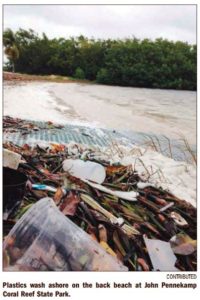We drive plastic cars, wear plastic clothes, eat with plastic utensils on plastic plates, buy food contained in plastic bottles and put it in plastic bags to bring it to our homes. We are addicted to plastic. In fact, Americans use more than 2.5 million plastic bottles an hour. Unfortunately, not only is plastic a staple in our home, it is also a major problem in the environment. Since 1862 when the first plastics were introduced, engineers have developed seven main types of plastics that are versatile, cost effective and durable. The durability of plastic is also one of the reasons it is so detrimental to the environment. Plastics can take centuries to break down.
 While most plastics can be recycled, we only recycle about 30 percent percent of the plastics we use. The remainder either is disposed in landfills or escapes into the environment. This is such a problem that by 2050 scientists project that the world’s oceans will contain more weight in plastics than in fish. The way plastics break down or degrade is an issue. When exposed to the sun, plastics do not biodegrade, but photodegrade. This means the plastic breaks down into smaller and smaller pieces until it becomes too small to see with the naked eye. These plastic particles, less than 5 mm long, are called microplastics.
While most plastics can be recycled, we only recycle about 30 percent percent of the plastics we use. The remainder either is disposed in landfills or escapes into the environment. This is such a problem that by 2050 scientists project that the world’s oceans will contain more weight in plastics than in fish. The way plastics break down or degrade is an issue. When exposed to the sun, plastics do not biodegrade, but photodegrade. This means the plastic breaks down into smaller and smaller pieces until it becomes too small to see with the naked eye. These plastic particles, less than 5 mm long, are called microplastics.
Even though we cannot see it, the plastic is still there causing harm to our ecosystem. In the ocean environment, zooplankton, small animals that make up the base of the food chain, have been observed ingesting microplastics. It is unknown what happens to the plastics after they are ingested. However, scientists believe there is a possibility that toxins in the plastic (like PCBs) can accumulate in the organism’s body and get passed up the food chain, eventually ending up on our dinner plates. Even though this is a huge problem, there are many things individuals can do on a daily basis to help reduce plastic waste.
Here are four easy practices to incorporate into your everyday life to help reduce your plastic consumption and your impact on the earth:
- Reuse containers instead of consuming more plastic. Use metal or glass water bottles for drinking and use your own reusable grocery bags for groceries.
- Refuse single-use plastics such as excess packaging, straws, utensils and plates. You can even bring your own reusable take-home containers to restaurants to bring home leftovers.
- Recycle! If you must choose plastics, look for ones that are no. 1 (PETE) or no. 2 (HDPE), as these are the most commonly recycled. Avoid polystyrene foam and plastic bags, as they have very low recycling rates.
- Spread the word. Do one thing to help with this issue and tell one person to help spread awareness of this problem.If you have questions, park rangers have many tips to share on how we can live greener. Look up a park near you at flordiastateparks.org. Becky Collins is a ranger at John Pennekamp Coral Reef State Park.
